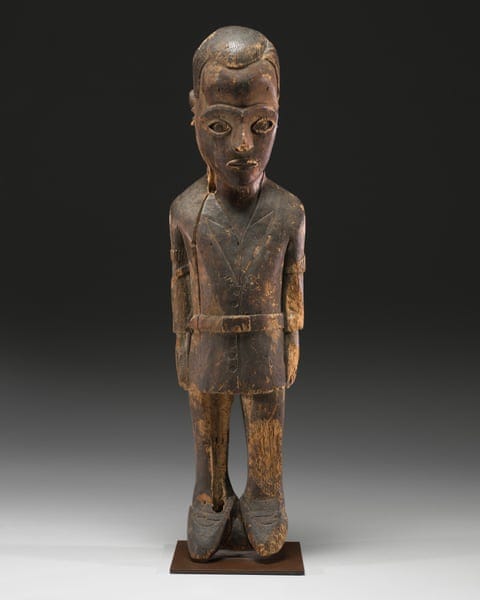🔅 Erik Prince's Latest Misadventure: Mercenaries in the Congo
Plus, Uganda's Digital Anti-Corruption Crusade & A Ghostly Presence at Venice Biennale
Photo of the Day

Spotlight Stories
Erik Prince's Latest Misadventure: A Mercenary Proposal in the Congo
Erik Prince has found his name lighting up the marquee of controversial reports once again. To re-jog your memory, Prince is man behind Blackwater and the unsavoury comments he made about colonialism we highlighted a few weeks ago:
This time, a UN paper has identified his presence, not on some distant desert battlefield but on the lush, resource-rich terrains of the Democratic Republic of the Congo's (DRC) North Kivu region.
According to the latest UN gossip column – also known as the report from December 2023 by the Group of Experts on the DRC – Prince has been caught red-handed trying to play matchmaker between 2,500 Latin American mercenaries and the ongoing conflict in North Kivu.
Now, if you're thinking, "Isn't that the place with all the minerals and constant fighting?" you're spot on. North Kivu is practically a magnet for trouble, and it seems Prince couldn't resist its pull. The UN's narrative paints a picture of Prince attempting to stir the pot in an already boiling-over conflict. With the DRC and Rwanda eyeing each other like heavyweight contenders, a UN peacekeeping mission packing its bags, and mercenaries popping up like unwelcome party guests, Prince's alleged deal reads like a recipe for disaster.
Rewriting the Lens: The True Story of Photography in West Africa

Once upon a time, the tale of early photography in West Africa was framed (pun intended) as a purely colonial endeavour. European adventurers, armed with their shiny new cameras, wove through West Africa in the mid-19th century. This version of events cast photography as another tool in the empire's kit, a way to document, and yes, to dominate, with the narrative firmly in the hands of the person behind the camera.
But, hold the flash!
What if this story was just the sepia-toned surface of a much deeper, richer tale? Giulia Paoletti, art detective and assistant professor at the University of Virginia, is flipping the script with her new book, "Portrait and Place: Photography in Senegal, 1840-1960."
Paoletti has excavated a hidden history, shining a light on unpublished works and giving names to faces and places long resigned to anonymity. Her mission? To debunk the myth that West Africans were merely subjects in the colonial gaze, passive figures waiting to be "discovered" by European lenses.
Instead, Paoletti introduces us to a world where, only a couple of years after photography's invention, West Africans themselves were grabbing cameras, seizing the narrative, and showcasing their own stories, their way. And that, dear readers, is a picture worth more than a thousand words.
#UgandaParliamentExhibition: The Digital Uprising Against Corruption
In Uganda, where taking to the streets can land you in hot water, citizens are turning to the digital sphere to air their grievances. Welcome to the #UgandaParliamentExhibition, a social media campaign that's causing more tremors in government circles than a disco on a Friday night. The exhibition showcases leaks and jaw-dropping revelations about how the country's coffers are being treated like a personal piggy bank by some in power.
The star of this not-so-glamorous show is Parliament Speaker Anita Among, who's been spotlighted for pocketing $894,500 in perks only (in less than a year). In a country where the average citizen earns $850 annually, these figures are scandalous.
Marlon Agaba of the Anti-Corruption Coalition Uganda sums up the exhibition best: it's a testament to the power of new media in sparking crucial conversations on governance. As Ugandans scroll, like, and share their way through the #UgandaParliamentExhibition, they're not just passing time online; they're part of a movement that's putting the spotlight on corruption, one post at a time.
A Ghost from the Past: The Balot Sculpture's Journey to Venice Biennale

The Venice Biennale is set to become a battleground for colonial discourse, thanks to a wooden statue with a spirit as fiery as its backstory. The sculpture, depicting Maximilien Balot, a Belgian colonial officer whose decapitation by the Pende people during a 1930s uprising in Congo, has been immortalized by an anonymous artist. But here’s the catch: the actual statue won't grace the Biennale. Instead, a livestream from a gallery in Lusanga, Democratic Republic of the Congo, will beam its presence into the Dutch pavilion, making it a ghostly attendee stirring debates from afar.
This move, orchestrated by the Dutch pavilion, is meant to challenge colonial amnesia and spark a conversation with the Belgian pavilion next door. It's like saying, "Hey neighbour, remember that time?" but with a lot more gravitas and historical baggage.
Balot's tale is the stuff of colonial nightmares - decapitated during the Pende people’s revolt, a response to unspeakable atrocities, his spirit was supposedly captured by an unknown sculptor weeks after his death. With Belgium's dark colonial past and the DRC's absence from the Biennale's pavilions, this year's event promises a moment for reflection, restitution, and, perhaps, a step towards reconciliation.
Food for Thought
“The worlds of the elders do not lock all the doors; they leave the right door open."
— Zambian Proverb






